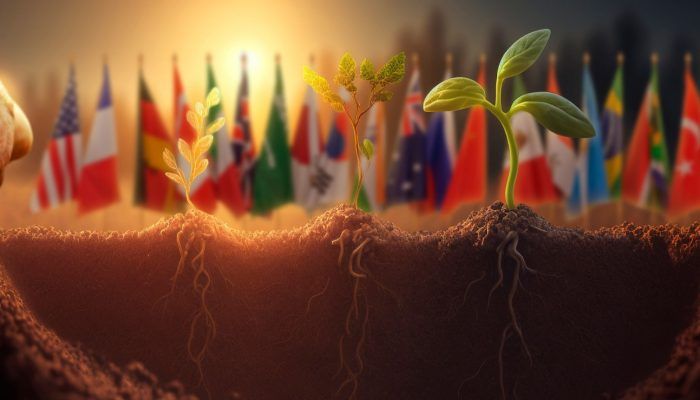Food Diplomacy 2.0: Six Building Blocks for Rebuilding Our Global Food System in an Age of Unpredictability
In a recent post, I discussed how the Russian invasion of Ukraine and the resultant chaos exposed just how fractured our global food supply is. However, it has also given us an unprecedented opportunity to reimagine and redefine the age-old concept of food diplomacy. We need to move from using food as a weapon and using it as a tool to build economies, resiliency, and connection — all of which will be critical as we move further into the 21st century.
Such an opportunity must acknowledge the realities of our food and agriculture systems and embrace the fragilities and fluidity that define our world. So, in a world defined by the convergence of the COVID-19 pandemic, climate change, geopolitics, panicky markets, and protectionist trade policies, how do we stop using food as a weapon and begin making food diplomacy part of the proactive planning and futureproofing we must do in an increasingly unpredictable world?
At the core of this new era of food diplomacy, are six building blocks that, if scaled properly, have the power to transform our global food system so that it will be more resilient and better able to meet the needs of a growing population in a connected yet resource-strained world.
- Rethink Humanitarian Aid. As World Central Kitchen founder José Andrés has pointed out, food is the fastest way to rebuild our sense of community. He’s proven his hypothesis time and again. However, we can’t depend on José Andrés to solve every logistical aspect of humanitarian aid. One of the big pieces of the puzzle that the Russia-Ukraine war has highlighted is shipping. Though global leaders planned and acted decisively on many fronts, the humanitarian plans that were developed before the war didn’t seem to factor in how to get much-needed grain out of the warzone and into markets that depend on it. In a global food marketplace that is dependent on food imports and hampered by extreme climate events, humanitarian aid can’t just be about feeding refugees; it needs to encompass feeding the world in times of uncertainty and disruption.
- Keep Markets Open. We need to discourage protectionist policies that harm market stability, smallholder farmers and global consumers. While bans may help politicians by keeping prices down, they don’t always help the people who need it most. The problem is worsened by burdening domestic producers and creating a domino effect in the global marketplace. It’s well known that global grain markets are even more concentrated than energy markets, and even less transparent. More must be done to encourage and incentivize markets to stay open. If restrictions are imposed, they need to be applied more transparently, and the WTO needs to enforce timely reporting of such bans so markets can plan and react accordingly.
- Re-invest in Crop Science. Even before the war started, the WFP warned that 2022 would be a difficult year. In 2021, China, the world’s largest wheat producer, experienced rains that delayed planting and forecasters predicted the crop would be the worst-ever; the Horn of Africa experienced its worst drought in four decades; and the lack of rain threatened other wheat-growing areas such as the U.S. wheat belt and the Beauce region of France. As the world warms and the weather becomes both less predictable and more volatile, we need wealthier economies who haven’t had to think about wheat shortages since the early 1970s to harness, invest in and apply the technologies that have been developed, so we have early warning systems that can predict where help may be needed and anticipate the need for — and implementation of — pre-cautionary measures.
- Incentivize Upcycling. One-third of the food produced for consumption is lost or wasted each year. Upcycling, which allows the food industry to get more from less by creating two or more products out of the resources that would have produced one, harnesses the nutritional value of by-products that would have otherwise gone to waste. With Del Monte launching products made with reused pineapple juice and EverGrain using AB InBev’s barley waste to make a protein-rich isolate, upcycling is quickly becoming a reality for both food ingredient and product producers. And, in addition to enhancing nutrition, products can be used to improve flavor and function. As our global food system continues to struggle under climate, political and economic volatility, upcycling offers producers the ability to reduce carbon emissions, enhance nutrition and recoup the nearly $1 billion FAO predicts is lost each year to food loss and waste. We can do this by incentivizing and supporting the upcycling movement so that upcycled ingredients and food products can disrupt the “take-make-waste” behaviors that define our current food production and consumption patterns.
- Fuel the Forgotten Foods Movement. Humans have cultivated about 7000 plant species as crops, but just three – wheat, corn, maize, and soybean — provide over half of our food supply. The shift towards more genetically uniform, high-yielding crops has threatened the biodiversity of our planet and left people malnourished. In several markets farmers have begun re-introducing crops such as cassava, amaranth, moringa, fonio, bambara groundnuts, kernza, and millet, which helps to diversify crops and nutrient supply. The forgotten foods movement needs to be further supported so that smallholder farmers are exposed to, and can learn from, successful modeling and capacity building, farming, conservation, seed exchange and sharing strategies. Food entrepreneurship needs to be encouraged around forgotten foods and chefs and nutritionists need platforms on which they can highlight the use and benefit of these crops.
- Put Sustainable Agriculture and Finance Tools in the Hands of Smallholder Farmers. Smallholder farmers are particularly vulnerable to the ravages created by geopolitical uncertainty, climate change and market instability. Yet, we have a food system that is dependent on 600 million smallholder farmers who are working on two hectares of land each to produce about 30% of the total crop production and about 32% of the world’s total food supply. For far too long, this critical group of producers has not had the tools or systems to prove their existence and fully participate in the supply chain. While agricultural technology can open access to weather- and crop-forecasting tools, sustainable financial inclusion — including the use of block chain and AI models — shows the promise of unlocking smallholder farmers’ full involvement in our global food supply, by providing the ability to record work histories and participate in credit and contract models that have been absent until now. Sustainable agriculture and finance, including models that are based in Web3, offer the opportunity for smallholder farmers to fully embrace and participate in the circular food and agriculture economy and be at the core of these solutions.
We are now living in the world we have been warned about for years. Climate change is here, pandemics remain as relevant in the 21st century as they were in the 20 previous ones, markets remain vulnerable to politicking and emotion, and geopolitical unrest makes our food supply chain even more vulnerable than ever. As frustrating and overwhelming as it all feels, let’s embrace the transformative opportunity we have before us to reimagine our global food system and welcome a new era of “Food Diplomacy 2.0.”




